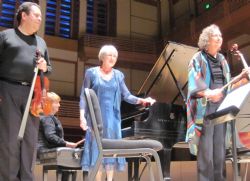|
Symphony
MYSTICAL PLANETS AND LIVELY GERSHWIN ORTIZ AT FINAL SRS CONCERT
by Peter Lert
Sunday, May 4, 2025
Symphony
VSO'S CONCERT MUSIC OF TIME, MUSIC OF PLACE
by Peter Lert
Sunday, April 27, 2025
Choral and Vocal
VOCAL ELEGANCE AND FIRE AT THE 222'S RECITAL APRIL 26
by Pamela Hicks Gailey
Saturday, April 26, 2025
CANTIAMO SONOMA SINGS AN INSPIRED GOOD FRIDAY MOZART REQUIEM CONCERT
by Pamela Hicks Gailey
Friday, April 18, 2025
DRAMATIC SHOSTAKOVICH SYMPHONY CLOSES PHILHARMONIC'S 25TH SEASON
by Terry McNeill
Sunday, April 13, 2025
LARGE COLLEGE OF MARIN AUDIENCE GREETS STOPHER ARTISTRY
by Terry McNeill
Saturday, April 5, 2025
Chamber
FRISSON DELIVERS SHIVERS OF DELIGHT
by Abby Wasserman
Sunday, March 30, 2025
OLD AND MOSTLY NEW IN SRS MARCH CONCERT IN WEILL
by Peter Lert
Saturday, March 22, 2025
Symphony
TWO FORMIDABLE SYMPHONIES AND PURPLE MOUNTAINS AT SRS CONCERT
by Peter Lert
Sunday, February 23, 2025
Chamber
THE PARKER CAPTURES DEMANDING ADES QUARTET AT RAC SEBASTOPOL CONCERT
by Peter Lert
Saturday, February 15, 2025
|
 |
 Trio Navarro in 2014 |
ARCANE ARENSKY TRIO HIGHLIGHTS NAVARRO'S SEASON OPENING CONCERT IN SCHROEDER
by Terry McNeill
Sunday, October 4, 2015
One would have thought that the glitz surrounding Lang Lang’s 101 Pianists Foundation program Oct. 4 in Weill would have upstaged chamber music at the same time in nearby Schroeder Hall. Not to worry, as the Trio Navarro continues to perform sometimes-neglected gems from the trio literature with a level of artistry that the Chinese superstar might grandly applaud.
In Rimsky-Korsakov’s My Musical Life he writes in 1905 that the works and life of his pupil Anton Arensky “…will soon be forgotten.” And that has mostly been so, with the exception of piano bagatelles, some suites, two string quartets and the first Trio in D Minor. The Navarro programmed the rarely heard second Trio in F Minor, Op. 73, for the second half of the concert, and scored a minor triumph with it before an audience of 125.
The Trio choose quick tempos and clipped phrases in the opening movement, eschewing extended ritards and the voice leading one hears in recordings of Arensky by Russian musicians. It’s Tchaikovsky influenced a bit by Schumann. A surprisingly movement ending accelerandowas played swiftly and vigorously. In the lyrical second movement pianist Marilyn Thompson played the opening expressive theme and throughout the music from 1905 is achingly rich, but even here in opulent thematic voices traded between violinist Victor Romasevich and cellist Jill Rachuy Brindel one hoped for a little more loosening of tempo. Mr. Romasevich held one high note at the end of an ascending phrase with just the right character of suspense and bright tone.
A Scherzo comprises a wonderful trio in a waltz form, and the concluding “Tema con Variazioni” with a big cello part portraying music that is less exalted than the preceding movements. It’s episodic until the return of the first-movement’s dark theme, and the Navarro played it with conviction. Brahms’ last movements are always imposing; Arensky’s are less so.
Before intermission the Navarro played trios by Haydn (B Flat Major, Hob XV:20) and the venerable Dvorak E Minor (“Dumky”). Haydn wrote more than 40 piano trios, and in most the cello supports the violin’s stating principal themes. It was this way in the first two movements with Mr. Romasevich’s light vibrato and a simple and long introductory line from Ms. Thompson in the Andante Cantabile. At times this Trio sounded like an accompanied piano solo, brisk and and pungent.
Dvorak’s famous Dumky has often been played by the Navarro, but with violinist Roy Malan. It’s a masterful work of vitality and infectious Czech rhythmic power in six alternating dumka of festive gaiety and yearning, though alike in character. The Navarro performed the demanding rhythm patterns with seasoned artistry. A highlight was the lovely recitative in the Poco Adagio sounding with Ms. Brindel’s plaintive cello melody, and the Cantilena in the piano part. In the fourth dumka again the cello carried a melancholy theme over the bass lines of piano and violin, and this created a sense of warm calm.
The final dumka (Lento) had the Navarro playing up the disparity of a grave pathetic theme with a wild quick section, and Ms. Brindel as earlier had prominence with her assured cello technique.
The repertoire selection and performance gave me no reason to change a decade-long view that the Navarro is the best resident piano trio in Northern California.
|
